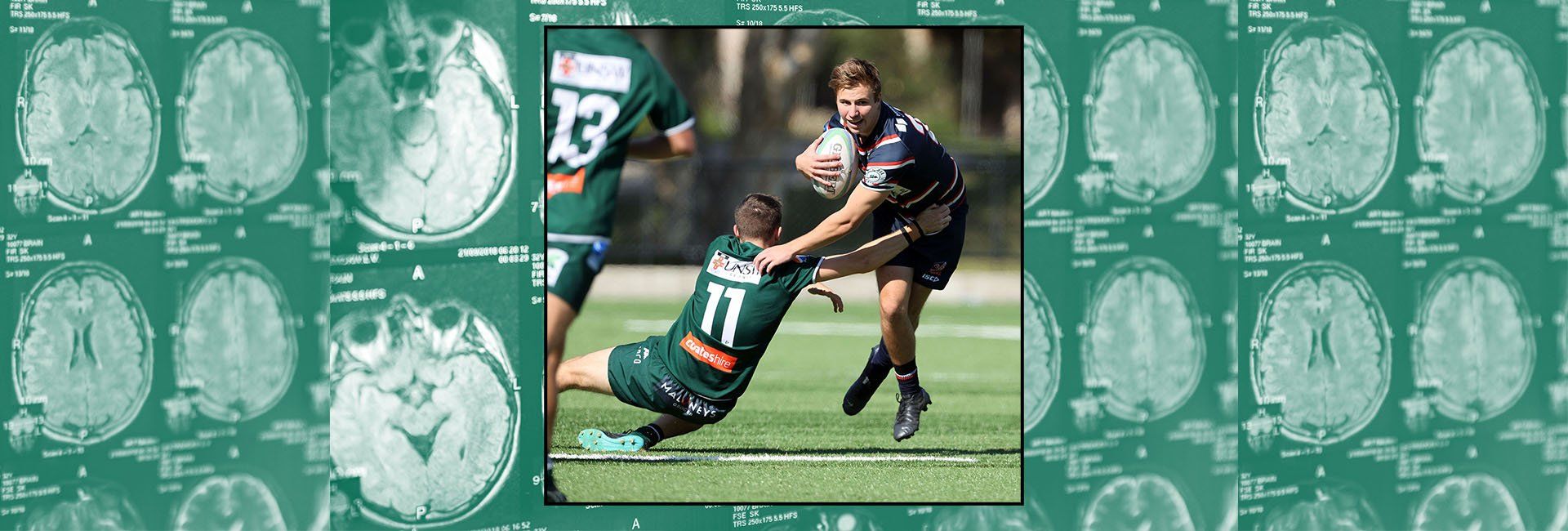As concussion-related injuries continue to mount in community-level sport, the tales of trauma go unheard.
When 20-year-old Jack Smith, sat "dazed, dizzy and confused" in the sheds after a regular round of club footy one Saturday morning, he was unaware it would be his final game ever.
During a weekend AFL game, the UNSW/Eastern Suburbs Bulldog player, then 20, was hit off guard by an intense blindside tackle from which he got up quickly, only mildly "shaken up". After the hit, he continued to play the rest of the game not knowing the severity of this sixth and final concussion would drastically change the next two years of his life.
“I only realised a little bit after the game that I was in trouble, I felt foggy and dazed,” said Smith, who was also a gifted rugby player. “The following day was when I knew something was seriously wrong here, I woke and had a serious headache, real stomach sickness and struggled to even stand and walk, the following symptoms weren’t like my previous knocks”.
'The worst part about this is that I never really received a date that I might start feeling better.'
The sporting world in recent years has struggled with how best to mitigate head-related trauma. Driven by a growing body of research, there has been a slow and rather painstaking consensus that concussion-related injuries aren’t just knocks you can "shake off" but rather knocks that can result in longterm brain trauma, particularly the neurological disease, chronic traumatic encephalopathy (CTE).
Now, many eyes are on arguably our most popular football code, Australian Rules football, which is perhaps one of the most concussion-prone sports world-wide. Concussions currently account for one in eight of injuries sustained in community Australian Rules football, according to the Australian Institute of Health and Welfare. In 2020-2021, there were 480 hospitalisations from concussion with injuries to the head or neck in 26 per cent of those cases.
The increasing regularity of reports of players suffering a concussion may go over our heads, but it certainly doesn’t go over the heads of regular club players such as Jack Smith, who was told by doctors and neurologists that he should never play any form of contact sports again.
“The doctors and neurologists were a frustrating place to go,” Smith said. “My whole life revolved around playing sport particularly contact sports such as rugby and AFL. It was a tough decision to call time on my passions but certainly the right one considering what I was continuing to battle with.”
When his symptoms persisted and worsened over a three-week period, Smith knew it was time to visit a specialist. He was finally diagnosed with post-concussion syndrome. This is an illness which is essentially a set of concussion symptoms that may continue and worsen for weeks, months or years after the initial knock. “The worst part about this is that I never really received a date that I might start feeling better,” Smith said.
This diagnosis not only stripped away his passion to play sport, but the illness was crippling in other areas of his life. The headaches went on for about 15 months, “450 mornings of waking up in pain and still having to carry on with day-to-day life”, he said. However, the most pernicious and debilitating symptom was the depersonalisation he experienced. This is a common side effect of head-related trauma and can be described as the persistent feeling of observing oneself from outside one’s body or having a sense that one’s surroundings aren’t real – it’s basically being detached and disconnected from your physical body, yourself, or thoughts, as if you were an outsider.
'I wish the first five times I was concussed, I was more accountable and informed of the dangers.'
For Smith, this major symptom became the worst and hardest to manage. “Every day I was in a constant feeling of not knowing myself and not trusting myself.
"I never wanted to see my friends, I never wanted to be with anyone else. It definitely had a major effect on my relationships, particularly with my friends and my girlfriend,” he said
Further, the symptoms interfered with Smith’s work and education. “At university I couldn’t concentrate and remember things, this ultimately resulted in me not passing several classes. At work I had serious trouble with some of the labour, if I lifted too heavy or worked too rapidly, I would get very light-headed and off balance. This all has only begun to get better 15 months later.”
Smith's experience is not an isolated one. At a Federal parliamentary committee hearing on head injuries in contact sports in April this year, Anita Frawley, the widow of late Melbourne Demon legend Dan "Spud" Frawley, gave evidence on the suicide of her husband, calling for more to be done to avoid CTE – the debilitating neurodegenerative disease caused by repeated head trauma.
An autopsy on her husband's brain by Associate Professor Michael Buckland of the Australian Sports Brain Bank showed he had Stage II CTE. Frawley, referring to the findings, argued there was a causal link between her husband's long-term exposure to contact sports, repeated concussions, severe brain trauma and the subsequent development of symptoms such as depression and anxiety, which eventually led to his death.
During the committee hearing, Frawley spoke emotionally to the panel of Senators, along with the AFL commissioners in attendance: “For me, this is not about blame or justice seeking. It’s simpler than that. It’s just about care. Care for the human beings.”
While even the top tiers of sports wrestle with the issue, caring for injured players is even more complex at a community sport level. There is a stigma about head injuries in players' minds, from acknowledging symptoms to challenging the diagnosis and accepting the necessary treatment. The question is how can players manage these knocks in the medium to long term in a preventative and curative sense?
At the grass roots level, club medical teams are small, and the staff are employed on a part-time basis. This conceivably impacts the thoroughness of concussion assessments and associated return to play practices.
As someone who has emerged from the difficult no-man's land of concussion symptoms, Smith has some ideas.
“If you aren’t sure if you’ve had a concussion, treat yourself like you have had one. If you’ve just been hit hard in the middle of a game and aren’t sure if you should keep playing, go off the field straight away and tell the doctors or coaches what happened. It’s important to prioritise your health, and often no one around you will realise that you’ve hurt yourself.”
In a research paper, led by Dr Hunter Bennett and published by the Journal of Science and Medicine in Sport, results found that junior football players who suffered a concussion were 1.5 times more likely to be re-injured in the future when compared to players who had never been injured before.
Bennett, from the University of South Australia, said, “the significant and elevated risk of injury after a concussion may suggest a longer recovery time is required for some players to better recover before returning to play.”
All of this is pointing to the need for more effort to be put into the support and management of optimal rehabilitation and injury prevention strategies for athletes who suffer from concussions, especially at a community level, where there is scarce funding, resources, and information around this issue.
Now 18 months on from his sixth and final concussion, Smith can happily say he is doing much better. “Whilst I’m not 100 per cent, having the ability for fitness to be incorporated back in my life again has made an immense difference and has really boosted my mental health, I have been running half marathons and picked surfing back up, one of my childhood hobbies.”
By sharing his story Smith hopes to spread awareness of the struggles surrounding concussions and to break the "tough guy" stigma. “It’s not being soft, it's being safe, there just simply isn’t enough protocol at club footy to know what the severity of your head knock is," he said.
“In hindsight I wish the first five times I was concussed, I was more accountable and informed of the dangers of concussions." He urges others who don’t feel right to let people know. “The support networks are always going to be there, you’re never alone.”
Kel is studying a Bachelor of Media (Communication and Journalism). He is interested in stories regarding sports, politics, and history.






As a checkout chick, I'm used to rudeness. But I can't bear the threats and violence